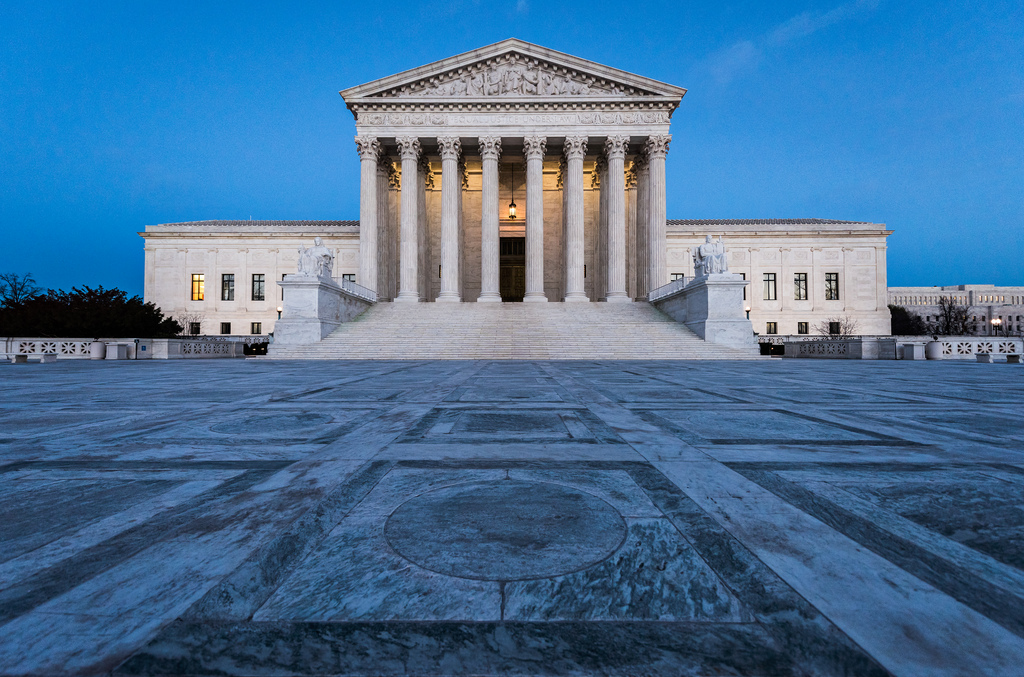Supreme Court Reinforces Mandatory Detention of Immigrants
The Supreme Court’s March 19 decision on in Nielsen v. Preap rejected challenges to mandatory detention of certain noncitizens—“aliens” under the Immigration and Nationality Act (INA). Generally speaking, mandatory immigration detention is an exception to the rule that confinement requires an individualized showing of flight risk or dangerousness.

Published by The Lawfare Institute
in Cooperation With

The Supreme Court’s March 19 decision on in Nielsen v. Preap rejected challenges to mandatory detention of certain noncitizens—“aliens” under the Immigration and Nationality Act (INA). Generally speaking, mandatory immigration detention is an exception to the rule that confinement requires an individualized showing of flight risk or dangerousness. Justice Samuel Alito, writing in Preap for five justices, concluded that the INA required detention for a broad range of aliens, including those who had been released from criminal custody years before their immigration arrests and had lived uneventfully in the community with their families for that entire period. Justice Stephen Breyer, joined by Justices Ruth Bader Ginsburg, Elena Kagan and Sonia Sotomayor, dissented, citing the familiar canon that a court should construe a statute to avoid serious constitutional questions. While Justice Alito’s opinion dealt solely with the INA, the substance and tone of his opinion suggested that future constitutional challenges to mandatory immigration detention would face formidable obstacles.
The INA provision at issue in Preap is 8 U.S.C. § 1226(c)(1), which requires immigration detention “when the alien is released” from custody based on conviction for a wide range of crimes, from crimes of violence and theft to possession of marijuana above a set threshold. Under the INA, each of these convictions constitutes grounds for the noncitizen’s removal. Lawful permanent residents (LPRs) are included among those who may be detained under § 1226(c)(1)—such as Mony Preap, who was born in a refugee camp to Cambodians fleeing the genocidal Khmer Rouge regime and became an LPR in 1981. Immigration officials detained Preap years after his convictions for possession of marijuana.
As Justice Alito noted in his opinion, Congress enacted § 1226(c)(1) in 1996, as part of the Illegal Immigration Reform and Immigrant Responsibility Act, because legislators believed that individualized bond hearings led to overly lax results. Bond hearings did not identify all flight risks: Even though most noncitizens granted bond appeared at their removal hearings, not all did—hence Congress’s resort to the drastic option of mandatory detention without a bond hearing.
Writing for the court, Justice Alito found that the provision’s “when … released” language did not require that the government either immediately detain any noncitizen released from criminal custody or else lose the power to subject that person to mandatory detention. Rather, Justice Alito concluded, the text of the provision and the policy driving its enactment meant that detention was mandatory for a noncitizen arrested at any time after release from custody, including years later.
Justice Alito’s policy point echoed an observation made by Justice Brett Kavanaugh at the October argument, which I analyzed here: Congress understood that requiring immediate arrest by immigration officials upon an individual’s release from criminal custody would often be impracticable. State and local authorities do not routinely notify federal immigration authorities in many such cases. Indeed, in a passage in his opinion that may signal openness to federal curbs on so-called sanctuary cities (see my piece here and Ilya Somin’s here), Justice Alito stated that in a recent three-year span, counties have declined over 20,000 federal requests to hold suspected removable aliens (pp. 19-20).
Given the gap between release from criminal custody and transfer to federal authorities, requiring an arrest immediately upon the noncitizen’s release would make mandatory detention effectively impossible in a substantial number of cases. Strictly as a matter of statutory construction—leaving constitutional issues aside—Justice Alito found it implausible that Congress would require mandatory detention but then set up immigration officials to fail much of the time.
The Supreme Court’s decision left some room for constitutional challenges to the statute. Justice Alito indicated that in cases where mandatory detention seemed arbitrary, a noncitizen might be able to mount an “as-applied” challenge to § 1226(c)(1) highlighting its unconstitutional effect in that particular case. As noted below, a successful as-applied challenge on due process grounds would show that a detainee had a reasonable prospect for ultimately gaining relief from removal, making his or her protracted detention a needless impediment to obtaining such relief. Neither Justice Alito’s opinion nor Justice Kavanaugh’s concurrence stressing the limits of the court’s holding explained what sorts of as-applied challenges might succeed. But Justice Alito’s substantive analysis implied that successful as-applied challenges would be rare; Alito’s lengthy textual discussion would have been superfluous if the statute would be clearly unconstitutional in most situations.
Even if at least five justices in a future case might hold in favor of an as-applied challenge, consider whether this is a sufficient constitutional safety valve. (Justices Clarence Thomas and Neil Gorsuch would presumably not be part of this group; Gorsuch joined a concurrence by Justice Thomas stressing barriers to federal court jurisdiction over challenges to detention provisions of the INA.) In some instances, application of § 1226(c)(1) may well be arbitrary. Because of the vast sweep of § 1226(c)(1), detention has extended even to noncitizens with solid arguments that their criminal convictions were not in fact grounds for removal or that they were eligible for relief such as cancellation of removal, which the INA provides to LPRs who have committed certain crimes but who also have accrued specific periods of time in continuous residence and LPR status.
Detention seems arbitrary in such cases, at least when a tribunal can spot in advance a strong argument that a given conviction is not an aggravated felony and the noncitizen has a good case for cancellation of removal. But the Supreme Court’s decision in Preap makes it more likely that at least some detainees with strong “as-applied” challenges to detention will nonetheless languish under government lock and key.
Cancellation recognizes longtime LPRs’ deep ties to the United States. Based on these compelling equities, cancellation is available if the noncitizen has not been convicted of serious charges such as theft, crimes of violence or drug-trafficking crimes that constitute “aggravated felonies” under the INA. LPRs who get cancellation retain their LPR status. Preap himself, in fact, ultimately received cancellation of removal. (Other members of the plaintiff class in Preap continued his challenge.)
But the statute as the Preap court interpreted it would require detention of noncitizens with strong cancellation of removal cases until an immigration tribunal actually granted their application for that relief. That confinement seems arbitrary, particularly given that an applicant with a strong case for relief has every incentive to appear for his or her removal hearing. Perhaps future as-applied challenges will establish that § 1226(c)(1) does not require detention without bond of an LPR with a strong cancellation case. But here’s the catch: A detained LPR may not have access to the legal representation required to determine what cancellation case is strong enough to meet this threshold.
Moreover, the complexity of defining an “aggravated felony” under the INA compounds some detainees’ plight. In last term’s Sessions v. Dimaya, the Supreme Court held that one prong of the definition of “crimes of violence”—an aggravated felony—was unconstitutionally vague. (In Dimaya, Justice Kagan wrote for the Court, joined by the three other liberal justices and Justice Gorsuch.) The Supreme Court has regularly issued decisions that clarify the scope of various aggravated felony provisions in the INA (see Moncrieffe v. Holder, holding that a state law prohibiting possession with intent to distribute marijuana permitted convictions for merely informally sharing the drug without receiving money in return; as a result, a conviction under the statute did not qualify as a “drug-trafficking crime”). After Preap, a noncitizen may have to litigate this difficult issue while detained in a remote location, with limited opportunity to obtain a lawyer. That litigation may take a long time, with the noncitizen remaining in detention.
Responding to both this and broader constitutional concerns about mandatory immigration detention based on conviction for minor crimes, Justice Breyer would have construed the statutory “when … released” language to give the government up to six months to arrest the noncitizen. After that period, Breyer would have held that the noncitizen could be detained only subject to a bond hearing to test dangerousness and flight risk. Breyer’s solution would have addressed the problem of arbitrary detention described above but would also have required a bond hearing for some noncitizens with no real defense against removal.
Justice Breyer’s approach would thus have second-guessed Congress’s finding that mandatory detention was necessary to ensure these individuals’ appearance at their removal hearings. In addition, Breyer’s interpolation of the six-month period arguably would have rewritten the statute; Congress could have given the government six months but chose not to write this particular period into § 1226(c)(1). The Preap majority rejected this statutory add-on as insufficiently tailored to any constitutional issues with the provision, which the majority preferred to address by allowing as-applied challenges when constitutional issues arose.
Preap’s reservation of constitutional issues for another day masks its substantial practical effects. Because of the Supreme Court’s decision, the government will have more power to detain more people without even a chance at bond. That is troubling in a constitutional system that generally requires an individualized showing as a predicate for detention. Some as-applied challenges may succeed; how many will do so depends on how robustly courts construe constitutional safeguards against arbitrary detention. But those as-applied challenges will turn on case-by-case contests in which detainees’ chronic lack of access to legal representation will pose severe limits.
Warning: Cannot modify header information - headers already sent by (output started at /var/www/lawfareblog.com/www/includes/common.inc:2786) in /var/www/lawfareblog.com/www/includes/bootstrap.inc on line 1499



.jpg?sfvrsn=676ddf0d_7)

